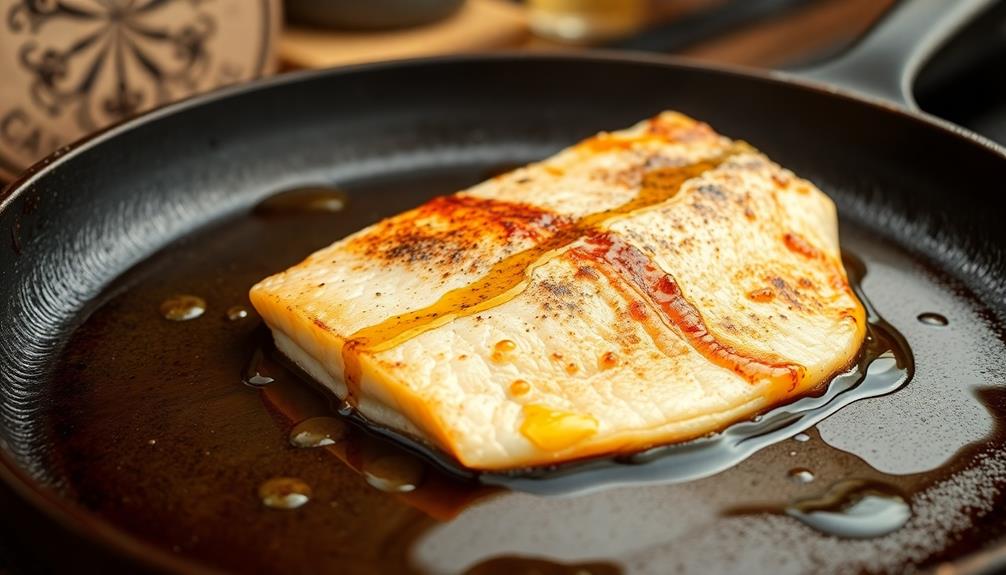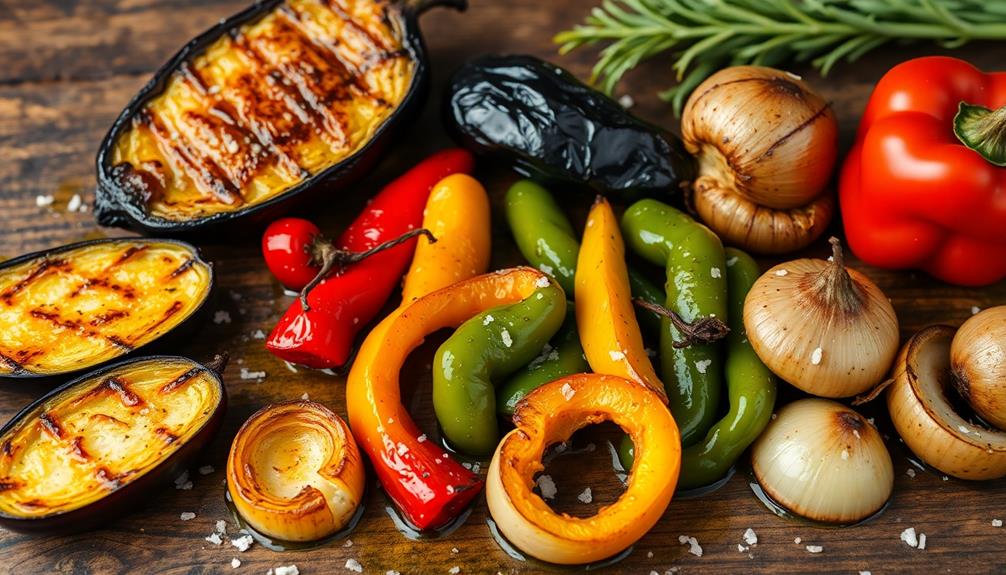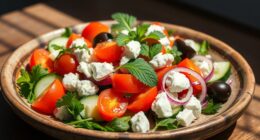Sepia a la plancha is a beloved Spanish tapas dish featuring grilled cuttlefish. It dates back to ancient Phoenician and Greek culinary traditions, now celebrated in seaside communities. To make it, you'll clean the sepia, pat it dry, and sear it over high heat for a crisp exterior and tender interior. Serve with fresh lemon wedges – the bright citrus beautifully complements the rich, briny flavor. This dish is not only delicious but also nutritious, low in calories yet high in protein and beneficial nutrients. If you're eager to explore more of Spain's captivating coastal cuisine, keep reading.
Key Takeaways
- Sepia a la plancha is a traditional Spanish dish of grilled cuttlefish, originating from coastal regions and commonly served as a tapas item.
- The dish highlights the delicate, briny flavor of the fresh squid, which is cooked over high heat to create a crispy exterior and tender interior.
- Preparation involves thoroughly cleaning the sepia, drying it well, and searing it in a hot pan or on a griddle until a golden-brown crust forms.
- Sepia a la plancha is often accompanied by fresh lemon wedges, which balance the richness of the dish and enhance its presentation.
- This dish is culturally significant, representing the coastal culinary traditions of Spain and the importance of fresh, local ingredients in Spanish gastronomy.
History
Sepia, a captivating ingredient in Spanish cuisine, has long been revered for its unique flavor and texture. This cephalopod, also known as the common cuttlefish, has been a staple in Mediterranean coastal regions for centuries. Its history can be traced back to ancient times, when the Phoenicians and Greeks first discovered the culinary delights of this succulent seafood.
In Spain, sepia a la plancha, or grilled cuttlefish, has become a beloved tapas dish, enjoyed by locals and tourists alike. The preparation involves searing the fresh sepia on a hot griddle, often seasoned with nothing more than salt, pepper, and a squeeze of lemon. This simple yet flavorful method allows the natural sweetness and tender chewiness of the sepia to shine.
Across Spain's seaside communities, families and friends gather to savor this iconic dish, celebrating the bounty of the sea and the rich gastronomic traditions that have been passed down through generations.
The aroma of sizzling sepia wafting through the air is a testament to the enduring appeal of this humble yet extraordinary ingredient.
Recipe
Sepia a La Plancha is a classic Spanish dish that showcases the delicate flavor and tender texture of grilled squid. This simple yet flavorful preparation allows the natural sweetness of the seafood to shine, complemented by the smoky char of the plancha (flat griddle) and a simple seasoning of salt and lemon.
The key to achieving the perfect Sepia a La Plancha is to source the freshest possible squid and to cook it quickly over high heat, ensuring that the exterior develops a crisp caramelization while the interior remains tender and juicy.
- Fresh whole squid, cleaned and cut into rings
- Olive oil
- Coarse sea salt
- Fresh lemon wedges
Heat a plancha or large cast-iron skillet over high heat until it's smoking hot. Drizzle a small amount of olive oil onto the surface and carefully add the squid rings in a single layer. Cook for 1-2 minutes per side, or until the squid is opaque and lightly charred.
Transfer the grilled squid to a serving plate and season generously with coarse sea salt.
Serve the Sepia a La Plancha immediately, with fresh lemon wedges on the side. The bright acidity of the lemon helps to balance the richness of the grilled squid.
For best results, enjoy this dish as part of a tapas-style meal, accompanied by crusty bread and a glass of chilled Spanish white wine. This dish is a perfect example of traditional Spanish cuisine, with its combination of fresh seafood and flavorful spices. The tapas-style meal allows for a variety of bites to be shared among friends and family, creating a communal and convivial dining experience. Pairing it with crusty bread and a glass of chilled Spanish white wine enhances the flavors and completes the traditional Spanish dining experience.
Cooking Steps
First, make sure to thoroughly clean the sepia and pat it dry.
Next, sear the sepia over high heat to get a nice char on the outside.
Step 1. Clean Sepia Thoroughly
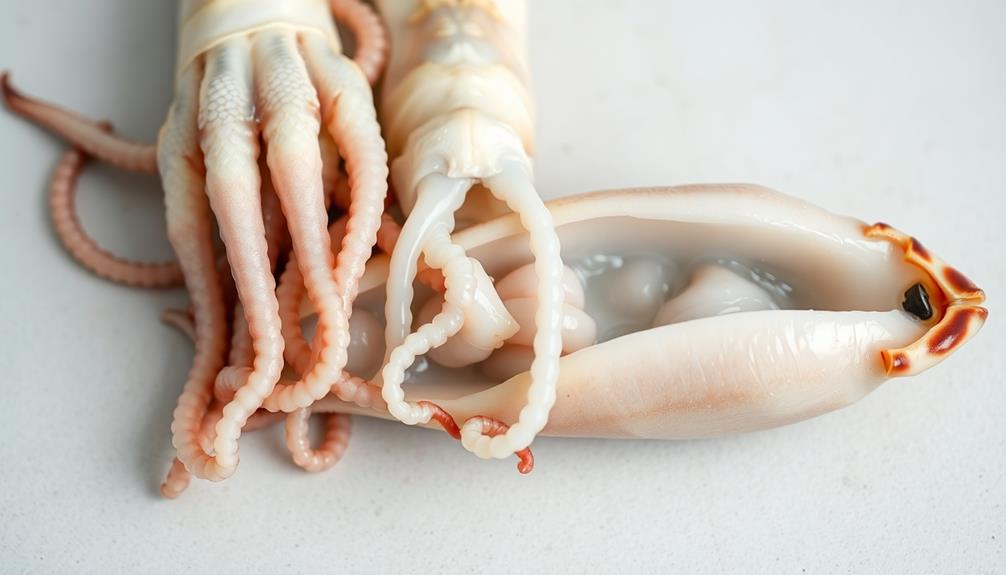
Before you can cook the sepia, it's essential to clean it thoroughly. Start by removing the thin skin and cartilage from the body. Use a sharp knife to gently peel away the skin, taking care not to damage the tender flesh.
Next, carefully extract the quill, which runs along the center of the sepia. Rinse the sepia under cold running water, gently scrubbing away any remaining impurities. Pat the sepia dry with a clean paper towel, ensuring it's completely dry before seasoning and cooking.
Once the sepia is clean, you can begin the cooking process. Season the sepia with salt, pepper, and any other desired spices.
Heat a cast-iron skillet or griddle over high heat, and when it's scorching hot, add a drizzle of olive oil. Carefully place the sepia in the pan and sear it for 2-3 minutes per side, until it's golden brown and slightly charred.
Serve the seared sepia immediately, garnished with lemon wedges and a sprinkle of fresh parsley, if desired.
Step 2. Pat Dry Sepia

Once the sepia is thoroughly cleaned, it's time to pat it dry. Grab a clean kitchen towel and gently blot the sepia, removing any excess moisture.
Be careful not to rub or scrub, as this can damage the delicate texture.
After blotting, use your fingertips to gently press down on the sepia, squeezing out any remaining water. Work in sections, ensuring each part is evenly dried. The sepia should feel dry to the touch, with no visible droplets of water.
Once the sepia is pat dry, it's ready for the next step in the cooking process. This step is crucial, as any excess moisture can interfere with the perfect sear you're aiming for.
Take your time and be gentle, and you'll have beautifully prepared sepia that's ready to be cooked to perfection.
Step 3. Sear Sepia Over High Heat
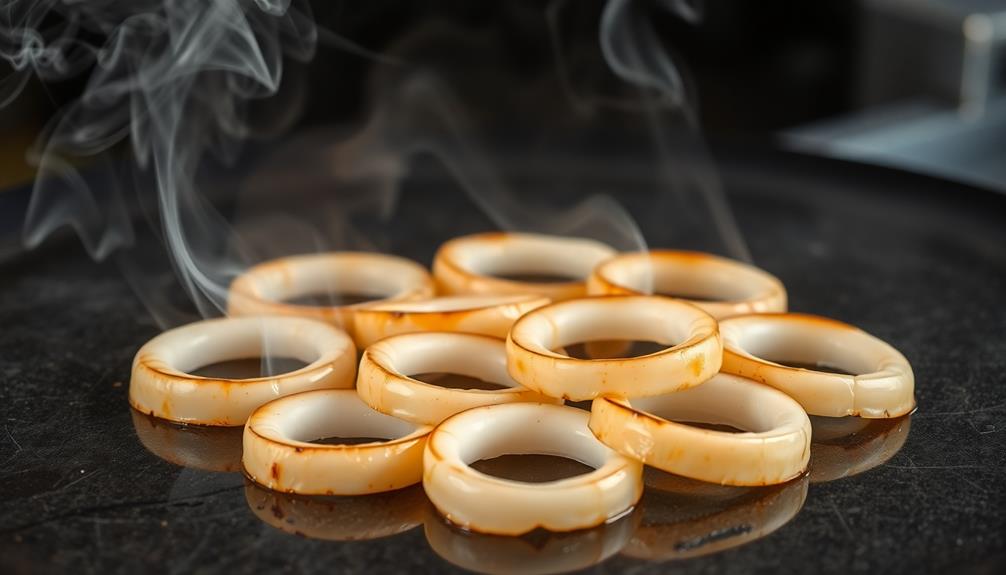
With the sepia now pat dry, it's time to sear it over high heat.
Grab a large skillet and crank the heat up to high. You want that pan ripping hot before you add the sepia.
Once the skillet is screaming, drizzle in a bit of olive oil. Gently place the sepia in the pan, making sure not to overcrowd. You want a nice even sear, so work in batches if needed.
Sear the sepia for 2-3 minutes per side, until you see a lovely golden-brown crust developing. Be careful not to move the sepia too much – you want it to get a good sear.
Once both sides are nicely caramelized, transfer the sepia to a plate. Repeat with any remaining pieces.
The key is getting that skillet blazing hot to ensure you get a perfect sear on the sepia without overcooking the tender interior.
With this technique, you'll have restaurant-quality sepia a la plancha in no time!
Step 4. Add Lemon Wedges for Serving
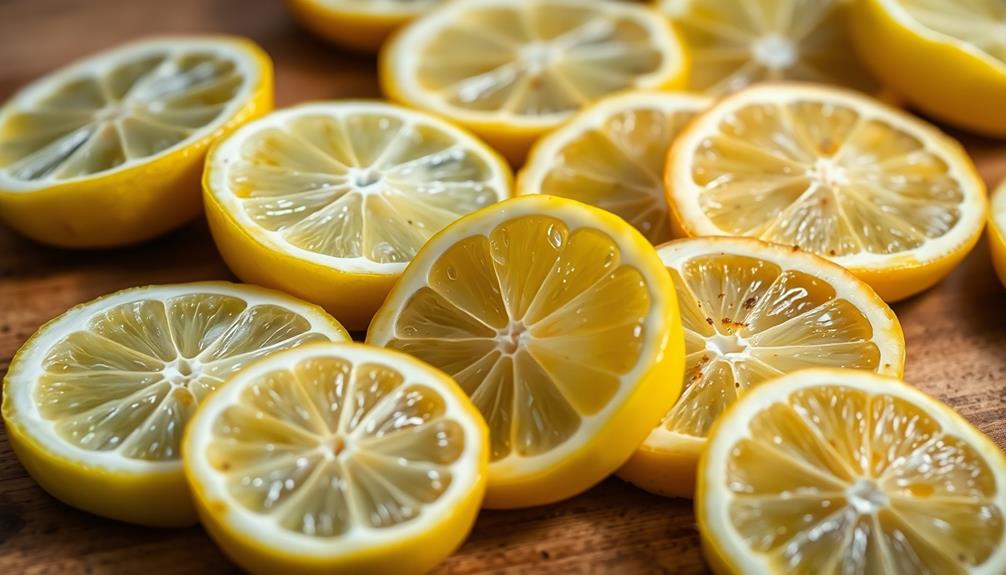
Now that your sepia is perfectly seared, let's add the finishing touch – lemon wedges for serving.
These bright, tart lemon slices are the perfect complement to the rich, savory sepia.
Simply take 2-3 fresh lemons and slice them into thin wedges. Arrange the lemon wedges around the seared sepia on your serving platter.
This not only adds a beautiful presentation but also allows your guests to easily squeeze the lemon juice over their sepia just before eating.
The citrus from the lemon will help to cut through the intensity of the seared squid, creating a well-balanced and flavorful dish.
Plus, the pop of color from the yellow lemon wedges makes this sepia a la plancha even more visually appealing.
Serve immediately and encourage your guests to generously squeeze the lemon over the sepia for the ultimate dining experience.
Step 5. Serve Immediately With Lemon Wedges
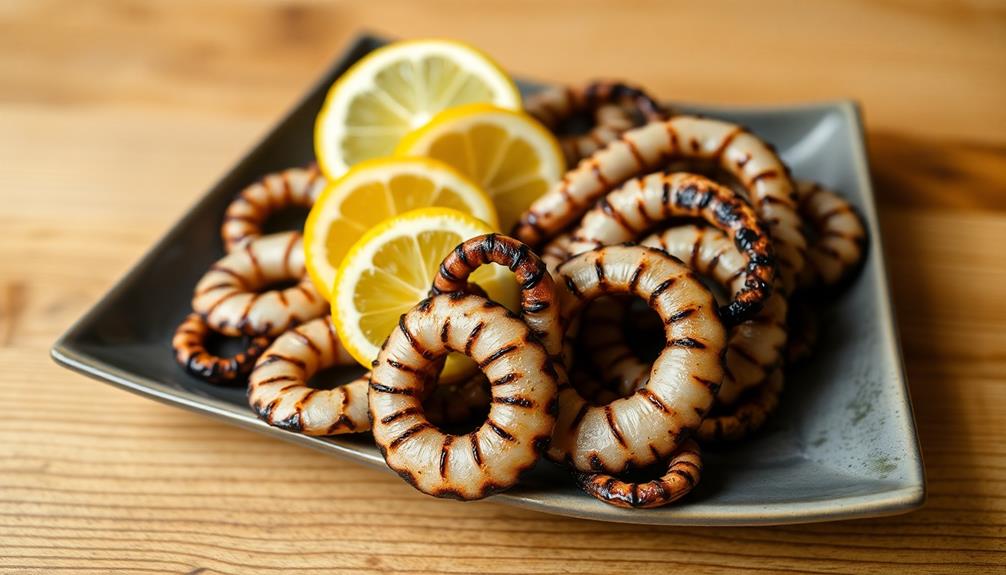
Serve the sepia a la plancha immediately, while it's hot and crisp. Squeeze fresh lemon wedges over the top, letting the tangy juice mingle with the savory, caramelized squid. The contrast of the tender flesh and charred edges is a true delight.
Garnish with a sprinkling of coarse sea salt to enhance the natural brininess of the seafood.
Serve the sepia with crusty bread, which is perfect for sopping up any leftover juices. You can also pair it with a simple salad or roasted vegetables for a well-rounded meal. The lemon wedges are essential, providing a bright, refreshing counterpoint to the rich, slightly smoky flavor of the grilled squid.
Enjoy this dish immediately, as the sepia is best when it's freshly cooked and still sizzling. The combination of textures and flavors is a true culinary experience, making it the perfect choice for a casual gathering or a special dinner.
Final Thoughts
Ultimately, the sepia a la plancha dish offers a captivating culinary experience. The distinctive chargrilled flavor, combined with the tender, succulent texture of the sepia, creates a memorable taste sensation.
Whether enjoyed as an appetizer or a main course, this dish is sure to delight your senses.
The preparation process, with its careful attention to timing and temperature, is a testament to the skill and artistry of the chef. The final presentation, with the vibrant lemon wedges providing a bright, acidic contrast, elevates the dish to a visually stunning masterpiece.
As you savor each bite, you'll be transported to the sun-drenched coasts of Spain, where this delectable dish originates.
The sepia a la plancha is truly a celebration of the sea, a harmonious blend of flavors that will leave you craving more. Indulge in this culinary gem and experience the magic of this captivating dish.
Frequently Asked Questions
What Is the Nutritional Value of Sepia a La Plancha?
Sepia a la plancha, a dish of grilled cuttlefish, is a good source of protein, selenium, and omega-3 fatty acids. It's low in calories and can be a healthy addition to your diet when enjoyed in moderation.
Is It Safe for People With Seafood Allergies to Consume?
If you have a seafood allergy, you should avoid consuming sepia a la plancha as it's made from squid, which is a type of seafood. Consuming it could trigger an allergic reaction, so it's best to steer clear.
How Long Can Leftover Sepia a La Plancha Be Stored?
Leftover dishes should be stored properly to ensure food safety. You can typically keep them refrigerated for 3-4 days. Be sure to store them in airtight containers and reheat thoroughly before consuming to prevent bacterial growth.
Can the Dish Be Made With Other Types of Squid?
You can absolutely use other types of squid in this dish. The key is to choose a fresh, high-quality squid that can withstand the high-heat cooking method. Feel free to experiment with different varieties to discover your favorite.
Is Sepia a La Plancha Commonly Served in Other Countries?
Is sepia a la plancha commonly served in other countries? You'll find similar grilled or pan-seared squid dishes across the Mediterranean and beyond, though the specific preparation may vary by region and local ingredients.
